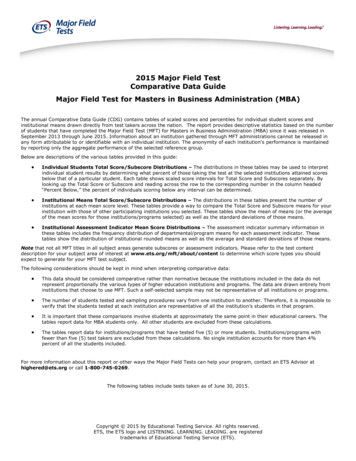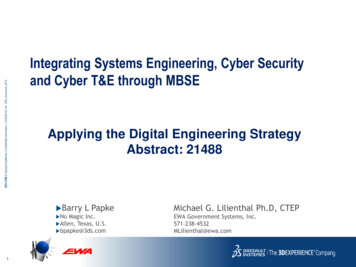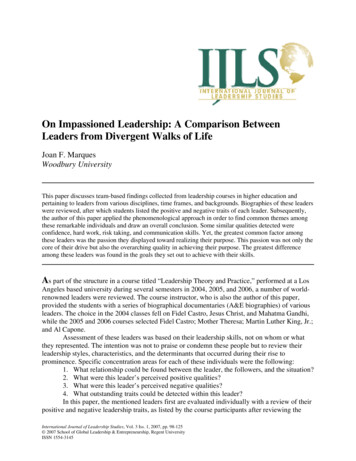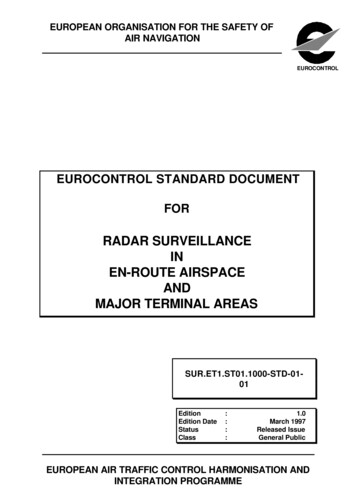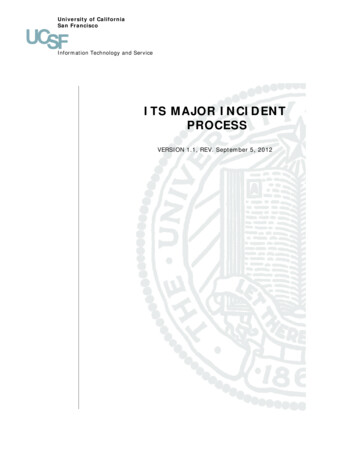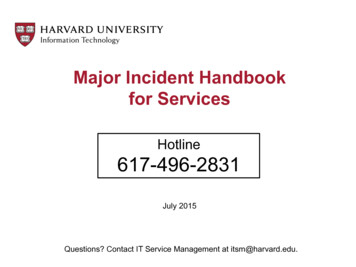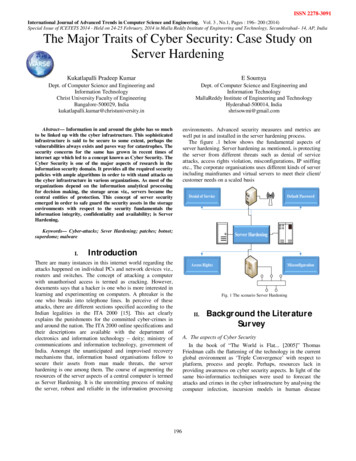
Transcription
ISSN 2278-3091International Journal of Advanced Trends in Computer Science and Engineering, Vol. 3 , No.1, Pages : 196– 200 (2014)Special Issue of ICETETS 2014 - Held on 24-25 February, 2014 in Malla Reddy Institute of Engineering and Technology, Secunderabad– 14, AP, IndiaThe Major Traits of Cyber Security: Case Study onServer HardeningKukatlapalli Pradeep KumarE SoumyaDept. of Computer Science and Engineering andInformation TechnologyChrist University Faculty of EngineeringBangalore-500029, Indiakukatlapalli.kumar@christuniversity.inDept. of Computer Science and Engineering andInformation TechnologyMallaReddy Institute of Engineering and TechnologyHyderabad-500014, Indiashrisowmi@gmail.comAbstract— Information in and around the globe has so muchto be linked up with the cyber infrastructure. This sophisticatedinfrastructure is said to be secure to some extent, perhaps thevulnerabilities always exists and paves way for catastrophes. Thesecurity concerns for the same has grown in recent times ofinternet age which led to a concept known as Cyber Security. TheCyber Security is one of the major aspects of research in theinformation security domain. It provides all the required securitypolicies with ample algorithms in order to with stand attacks onthe cyber infrastructure in various organizations. As most of theorganizations depend on the information analytical processingfor decision making, the storage areas viz., servers became thecentral entities of protection. This concept of server securityemerged in order to safe guard the security assets in the storageenvironments with respect to the security fundamentals theinformation integrity, confidentiality and availability; is ServerHardening.environments. Advanced security measures and metrics arewell put in and installed in the server hardening process.The figure .1 below shows the fundamental aspects ofserver hardening. Server hardening as mentioned, is protectingthe server from different threats such as denial of serviceattacks, access rights violation, misconfigurations, IP sniffingetc., The corporate organisations uses different kinds of serverincluding mainframes and virtual servers to meet their client/customer needs on a scaled basisDenial of ServiceKeywords— Cyber-attacks; Sever Hardening; patches; botnet;superdome; malwareI.Default PasswordServer HardeningIntroductionThere are many instances in this internet world regarding theattacks happened on individual PCs and network devices viz.,routers and switches. The concept of attacking a computerwith unauthorised access is termed as cracking. However,documents says that a hacker is one who is more interested inlearning and experimenting on computers. A phreaker is theone who breaks into telephone lines. In perceive of theseattacks, there are different sections specified according to theIndian legalities in the ITA 2000 [15]. This act clearlyexplains the punishments for the committed cyber-crimes inand around the nation. The ITA 2000 online specifications andtheir descriptions are available with the department ofelectronics and information technology – deity; ministry ofcommunications and information technology, government ofIndia. Amongst the unanticipated and improvised recoverymechanisms that, information based organisations follow tosecure their assets from man made threats, the serverhardening is one among them. The course of augmenting theresources of the server aspects of a central computer is termedas Server Hardening. It is the unremitting process of makingthe server, robust and reliable in the information processingAccess RightsMisconfigurationFig. 1 The scenario Server HardeningII.Background the LiteratureSurveyA. The aspects of Cyber SecurityIn the book of “The World is Flat. [2005]” ThomasFriedman calls the flattening of the technology in the currentglobal environment as ‘Triple Convergence’ with respect toplatform, process and people. Perhaps, resources lack inproviding awareness on cyber security aspects. In light of thesame bio-informatics techniques were used to forecast theattacks and crimes in the cyber infrastructure by analysing thecomputer infection, incursion models in human disease196
ISSN 2278-3091International Journal of Advanced Trends in Computer Science and Engineering, Vol. 3 , No.1, Pages : 196– 200 (2014)Special Issue of ICETETS 2014 - Held on 24-25 February, 2014 in Malla Reddy Institute of Engineering and Technology, Secunderabad– 14, AP, Indiacollaboration among the universities on the cyber securityaspects with respect to the academics and research. The cyberresearch teams would not only address the computer science,electrical engineering, software and hardware security, alsosocial sciences, political science and ethics, law etc., in theyears to come. The Information Technology Act-ITA, is clearwith all the legalities well defined in the document released bygovernment of India. Perhaps, awareness of the same amongthe common citizens in the country is still a big challenge forthe government agencies. However, ambiguity among thecyber-crimes and cyber laws should be well understood andaddressed for better judgments in the court of law [8]. From itsinception, researchers have given the term ‘security’, plethoraof definitions. But, the demarcation and descriptions onsecurity were framed in terms of vulnerabilities or theirabsence. The security should be managed and run by pursuinga policy according to the organization’s infrastructure. So thefocus is, to shift from the traditional vulnerability checking tomeasuring the security attributes; which helps to reasonsecurity in terms of observable entities rather than conjectured,theorized causes [9].models [1]. The security metrics and measures availableprovides a plenty of choices which are proved to be efficientin many dynamic environments. These metrics were alsocustomized for protecting especially the intelligent urbaninfrastructure systems such as Intelligent Transport Systems(ITS), Smart Grids, Cognitive Radios etc., [3].In the regions of central Europe, Croatia, the copy rightviolations attracted the researchers to investigate and focus onthe cybercrimes. Cluster of different groups have beenexamined on the awareness of intellectual property, copyrightlaws in the nation and the violation of copy rights both in realworld and virtual world [2].CyberSecurityServer HardeningInformationSecurityNetwork Security Disaster RecoveryB. The aspects of Server HardeningIn order to provide good security for the servers especiallyemail servers, a new mechanism was developed to analyse thespam sending systems. This takes the advantage of clusteringthe spam based on IP addresses resolved from URLs with inspam emails rather than clustering spam according tosimilarities based on email contents or URLs or domain names[10]. As a part of server hardening process, an error ratenamed the soft error rate (SER) is calculated. The impact ofthe soft error is limited to the extra compute time required forcorrection. Collating all these factors with respect totransistors and various inner circuits’ results in raw soft errorrate. If the higher level layers and the bottom level layers arewell protected, then this kind of protection mechanism leads toaugment severs for sturdiness [11]. Providing overall securityfor the global internet is unmoving in some contexts and ahuge challenge for the IT administrators. In pursuit of thesame, researchers focused on some aspects of DNS serviceswith respect to security. The DNS services can be secured byconstantly cleansing the servers as a part of sever hardeningprocess and also rotating the role of individual servers. Thisintrusion-resilient strategy contributes considerably to the totalretreat of the Internet [13].The web security hardening can be done by the deploymentof reverse proxy with intrusion detection and preventionmechanisms en suiting against web attacks particularly SQLinjection kind of attacks [14]. Statistical frameworks aredeveloped for analysing honeypot arrested cyber-attack files.These frameworks are applied on the low-interaction andhigh-interaction sample honeypot datasets resulting in longrange dependence (LRD) on honeypot-captured cyber-attacks.Such experiments led to feasible prediction of cyber-attacks inthe organizations providing ample early warning time [12].EducationAnd ResearchFig. 2 The security linked with the Cyber SecurityIn the view towards progressing cyber security informationsharing, the Cyber Security Data Exchange and CollaborationInfrastructure (CDXI) has emerged providing a knowledgemanagement tool for enhanced cyber information sharing andvetting of data burden sharing collaboration. The abstract levelrequirements have been analysed for a better CDXI concept[4]. As a part of cyber security initiative the Russiangovernment brought in on a cyber space policy “DraftConvention on International Information Security [2011]”, andthe Russian military cyber proto-doctrine “Conceptual Viewson the Activity of the Russian Federation Armed Forces inInformation Space [2011]”. The political response of theRussian authorities were recorded and drafted as a case studyby the researchers [5].A survey on the cybercrimes and attacks were recentlyconducted by the researchers in collaboration with ‘AndhraPradesh Police Academy Hyderabad’ [6]. It presented a briefdescriptions on cyber criminals and crimes, types, casestudies, preventive measures. The work also focused on thegovernment agencies/ departments exclusively working on tocombat cyber-crimes in India. The revolution on the protectionof the cyber environments led to the theory of cyber security.Now the trend towards cyber operations does not only meansecuring urban infrastructure systems, but also cyber securityresearch and education [7]. There is a great need for197
ISSN 2278-3091International Journal of Advanced Trends in Computer Science and Engineering, Vol. 3 , No.1, Pages : 196– 200 (2014)Special Issue of ICETETS 2014 - Held on 24-25 February, 2014 in Malla Reddy Institute of Engineering and Technology, Secunderabad– 14, AP, IndiaIII.of security features. As the servers were running highlycritical government applications it was not possible to put thepolicies into the enforced mode from day one, so initially allthe policies were planned to put in the warning mode. It was achallenge in itself to provide with the accurate completiontimelines to the project due to the close monitoring requiredfor critical application and other components before enforcingthe policiesCase Study IA. Problem ScenarioThe Government of India’s collection of Direct and IndirectFunds were vulnerable to security treats. Torrid implementsthe required security measures called CA eTrust AccessControl for Government of IndiaB. Analysis of the CaseCustomer is a prime department under Government ofIndia and processes highly sensitive financial informationacross its data centers distributed at different locations inIndia. The department is mainly responsible for mattersrelating to levy and collection of Direct and Indirect funds.D. Solutions ObtainedTorrid deployed CA’s eTrust Access Control to counter theabove challenges faced by the customer. Our security expertsinteracted with client’s team to understand the basic design ofthe architecture, target customers, end users, and confidentialassets to design eTrust Access Control framework and itspolicy model database (PMDB) for implementation which isused to distribute policies to clients from the servers.There were a total of 12 superdome servers which werehaving a pool of 68 virtualized servers distributed over 4locations in India. The pool of servers further compriseddevelopment, pre-production and production servers. It was ahuge pool, so starting with the best and right framework wasundoubtedly an essential pre-requisite.C. ChallengesThe sheer size and type of the organization made it mostvulnerable for security breaches. There was need for a highlevel of availability, performance density, memory scalability,and investment protection therefore they implemented HpSuperdome Servers at multiple data centers distributed overdifferent locations in India running HP-UX 11i operatingsystems. The major challenges that were faced in the serverinfrastructure as described below:The following steps were taken to implement the solution inthe architecture:1. Installation of eTrust Access Control server on adedicated server.2. As per requirements, a Master PMDB and its sub-groupPMDB’s were installed on the eTrust Access Control server.3. Baseline security policies were discussed with their teamand enforced on the master PMDB as these policies should beon each and every host and thereafter policies on different subgroup PMDB were discussed and enforced. As there werevery critical production servers, so all the policies were put inthe warning mode.4. After designing the architecture of eTrust AccessControl, installation and customization of the eTrust AccessControl client was done on each server and subscribed to therespective PMDB.5. Warnings on all the servers were regularly monitored forsome time, discussed with their team and then put in therestrictive mode1. Role-Based Access Control and Superuser Containment:Superuser accounts were often shared by applicationoperators, leading to ambiguous accountability. There was noavailable method to restrict or delegate operators based on“who will use it”.2. No centralized enforcement administration: There weremajor platform security differences that existed along withlack of remote policy administration which lead to a highlydecentralized system. Decentralization pointed to lack ofmanageability which was a big problem for the management.3. Unrestricted Superuser: Superuser account, which haveunlimited access and authority, were unrestricted makingbreaching a cake walk like target for hackers. Imagine one ofthe bad Guys in your backyard having access to your assets.4. Inadequate auditing: Native auditing procedures wereinadequate with a very low granularity level in the OperatingSystem. Audit logs were accessible to Superusers fortampering and auditing processes could also be shut down atany time. Due to no presence of self-protecting mechanismagainst attacks pilferage, native logs would not be in a positionto keep track of the original login and thus culprit couldescape easily.5. Consistent Cross-Platform Problems: Different platformshave different security models and for the same reasondifferent strategies need to be used for handling the difficultiesin managing various security systems which, in turn, alsoincrease management costs.Torrid understood the challenges faced by the customer topropose CA eTrust Access Control (AC) software that couldeasily mitigate the risk of different threats. eTrust AC providescapability to manage centralized access control on differentservers using policy enforcement mechanism along with lotsE. ResultsAfter analysing the challenges, Torrid’s technical expertisehelped the execution of the project and the successfulimplementation was rolled out in the first phase itself withoutsecond iteration. All the documentation was handed over tothe client and further assistance was readily available forsupport and solving issues.Following benefits were reaped by the client due to thesolution implementation:1.Role-Based Access Control and SuperuserContainment: By using the solution, super userprivileges were fully contained and delegated. Therewas no back door to bypass checks and gain full198
ISSN 2278-3091International Journal of Advanced Trends in Computer Science and Engineering, Vol. 3 , No.1, Pages : 196– 200 (2014)Special Issue of ICETETS 2014 - Held on 24-25 February, 2014 in Malla Reddy Institute of Engineering and Technology, Secunderabad– 14, AP, India2.3.4.5.control of the system or unauthorized access to filesand services.Centralized Enforcement Administration: Solutiondelivered a uniform level of security by bringingsecurity up to correct level. It provided a centralizedsecurity control which allowed enterprise widemanagement of access enforcement and tracking withthe help of Policy Model Database using a pushmechanism to sequentially update the subscribers.Administrators could easily create, delete, suspend,revoke and expire user accounts centrally. They couldalso enforce password rules, quality, history, intervaletc.Data Protection: Solution helped protectingconfidential and sensitive data against hackers andthefts through identity based granular access controlfor all files through its Host Based IntrusionPrevention feature.Secure Auditing: The solution offered a very secure,scalable and reliable means to collect and reportaccess information – It provided secure audit logs –generated locally with possibility of being collectedcentrally.Consistent Security Policies: CA eTrust AccessControl provided consistent security policy across allthe HP-UX partitionsC. Solutions ObtainedIn early 2011, Microsoft lawyers and U.S. marshals seizedcommand-and-control servers for the Rustock botnet, whichwas housed at several web-hosting providers across the UnitedStates. Microsoft’s anti-botnet actions combined with thecompany’s numbers of vulnerability patch releases helped toclamp down on criminal activity—have turned it into acybercrime crusader.D. Resulting ContentsSince Microsoft was sidelined by Rustock, daily spamvolume worldwide has dropped dramatically and the botnet’sactivity slowed to a halt.The victories against the botnets are certainly welcome.Spam wastes the time, disk space, bandwidth, and money ofeveryone affected, and killing the botnets responsible for sucha large proportion of spam undoubtedly benefits the Internet.But it remains an up-hill struggled for the good guys, withplenty of other botnets out there to fill our inboxes with whatis at best drivel, and at worst outright dangerous!E. Social RelevanceIn the U.S., an estimated 86,000 Rustock-infected PCs inMarch had been reduced to some 53,000 by June 2011, a dropof 38% afterwards. Other countries saw even biggerreductions such as in India, the March 2011 tally of 322,000infected machines plummeted by 69% to approximately99,000 in June.The Microsoft’s Active Response for Security (MARS)team oversees the botnet effects and shared its findings aboutbotnets with other members of the security industry. Thisincludes taking down botnets (armies of malware-infected PCsoperating secretly under the remote control of a criminal),seizing the infrastructure and domains criminals use to controlthem and taking the information we gain in those efforts tohelp better protect the Internet community and our customers.Project MARS is a joint effort between the MicrosoftDigital Crimes Unit, Microsoft Malware Protection Center,Customer Support Services and Trustworthy Computing.Recent examples of MARS include: Operation b49 (theWaledac takedown), Operation b107 (the Rustock takedown),Operation b79 (the Kelihos takedown) and Operation b71 (theZeus disruption)CASE STUDY IIA. Problem ScenarioBotnet owners had exploited the Windows OperatingSystem. Microsoft equipped the systems to fight againstbotnets and provided permanent solutions.B. Analysis of the CaseBotnet is a network of private computers infected withmalicious software and controlled as a group without theowners' knowledge e.g. to send spam emails.RevenueOnlineBlackMarketBot-herder Ownerand OperatorIV.Click FraudIdentityTheftSpammerBOTNETThousand ofcompromisedcomputersConclusionEvery server security conscious organization will have theirown methods for maintaining adequate system and networksecurity. Often you will find that server hardening consultantscan bring your security efforts up a notch with theirspecialized expertise.Spam RunsPhishingAttacksSome common server hardening techniques are to use dataencryption for your communications, avoiding use of insecureprotocols that send information or passwords in plain text.Minimizing the unnecessary software on t
the required security measures called CA eTrust Access Control for Government of India B. Analysis of the Case Customer is a prime department under Government of India and processes highly sensitive financial information across its
